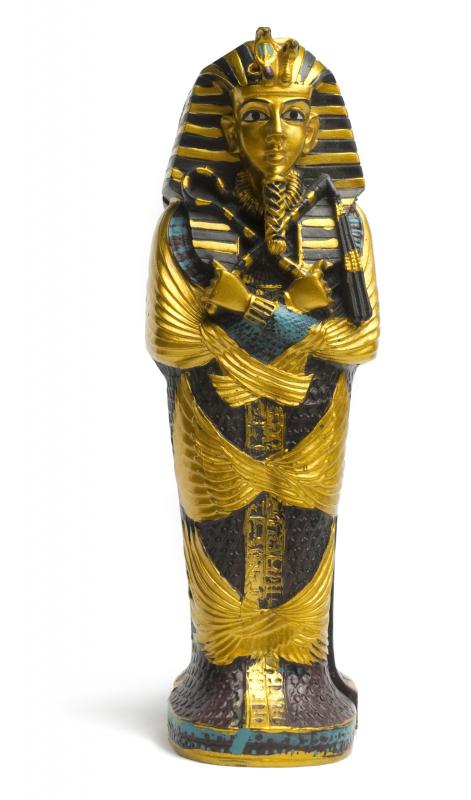At WiseGEEK, we're committed to delivering accurate, trustworthy information. Our expert-authored content is rigorously fact-checked and sourced from credible authorities. Discover how we uphold the highest standards in providing you with reliable knowledge.
What is a Sarcophagus?
A sarcophagus is a burial container which is carved from stone. Traditionally, many sarcophagi are made from limestone, although a wide variety of types of stone may be used, including granite like that used to make King Tutankhamen's famous sarcophagus. Many people associate the sarcophagus with classical antiquity, since these burial containers were extensively used during this period, although such burial containers continue to be used in some regions today.
The origins of the word “sarcophagus” are rather interesting. The term is derived from the Greek sarx, or “flesh” and phagein, which means “to eat.” The Greeks believed that sarcophagi literally ate the bodies stored inside, dissolving the bones within a very short period of time, especially when they were carved from limestone. The word was borrowed by the Romans, although the interesting idea about decomposition wasn't, and it has since filtered down into the English language.

Numerous ancient cultures used sarcophagi, typically for extremely prominent dead like royalty and civic leaders. In China, ornate stone sarcophagi were used to bury members of the royal family, and they were often elaborately carved, and sometimes inlaid with gold and precious gems. In Egypt, the sarcophagus was used as the outer burial container, typically designed to be large enough to hold a coffin, and sometimes a nesting set of coffins which were meant to prevent decay. The Greeks, after the sixth century, along with the Romans, also used sarcophagi, some of which can still be seen today.

Classically, a sarcophagus is just a big stone box. In some cultures, it is traditional to carve an effigy into the lid of the sarcophagus, depicting the face of the dead person, and in some cases, and effigy may be an entire body. Sarcophagi are also traditionally ornamented with a variety of carvings, many of which feature objects of symbolic significance in addition to decorative value. A sarcophagus may also be lined in lead or other materials to slow the rate of decay.
Although the Greeks may have believed that the sarcophagus would eat bodies, later cultures chose these burial containers because of their indestructibility. They were used as monuments to mighty people in society, and they also kept out grave robbers who might have been interested in jewelry, textiles, and other grave goods which might have been buried with the dead. Today, several examples of ancient sarcophagi are on display in museums all over the world, so that visitors can admire their craftsmanship.
AS FEATURED ON:
AS FEATURED ON:












Discussion Comments
@sunnySkys - I remember my first time going to the Egyptian mummy exhibit in the museum! This was an art and history museum combination, and the whole Egyptian exhibit was just amazing. They had a pharaoh's sarcophagus as the centerpiece to the exhibit.
I don't think it's just the mummy movie mythos that makes seeing a sarcophagus in person so awe-inspiring. When I first saw the one in the museum, I simply sat and stared -- I couldn't take my eyes off of it.
The realization that this item was so ancient, and so perfectly preserved, was just amazing to me, and I had seen them in photos dozens of times before, but seeing the sarcophagus in person really drove the point home.
For anybody reading this, if you haven't seen a sarcophagus in person before, you really ought to. It's an experience.
@yseult - It's definitely a romantic idea. Perhaps that's why the Egyptian sarcophagus was mostly reserved for people of some stature and importance?
@JessicaLynn - It may seem silly to us today, but for the people burying the body, it was a very important matter. Many of them believed that the pharaohs and priests were holy in some way.
With respect to the Egyptians, to simply have the body decompose would liken it to a common person or even an animal! I mean that there would be some loss of dignity to the deceased.
By preserving the body in a gold sarcophagus, they allowed themselves to hold onto the believe that the body would remain intact and thus be suitable for traveling into the next world.
@sunnySkys - Egyptian mummy exhibits are pretty neat. One of my local museums partnered with a local hospital and did some medical imaging of one of the museums mummies to find out what the cause of death was. It turned out to be a dental abscess!
I think it's interesting that originally a sarcophagus was supposed to speed up decomposition. Then it was supposed to slow it down! I suppose different cultures have different ideas about funeral and burial arrangements. However, being concerned over the rate of decomposition after burial seems a little silly to me.
I used to live in the city right down the street from an art museum. One of my favorite exhibits was the Egyptian mummy exhibit, complete with sarcophagi!
The exhibit showed sarcophagi from a few different eras and from people in a few different age groups. Some of them were definitely more intricately decorated then others-for instance, one of them was inlaid with gold! Others were decorated a little more plainly.
Post your comments